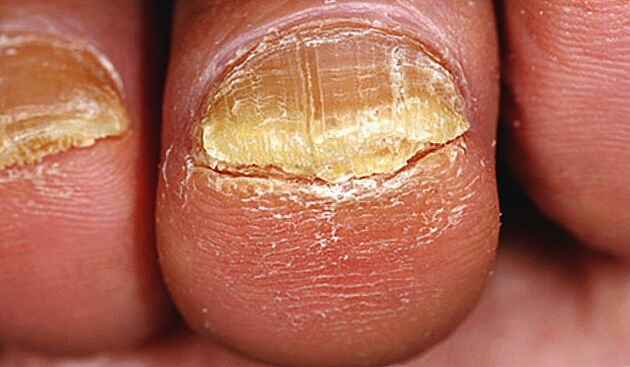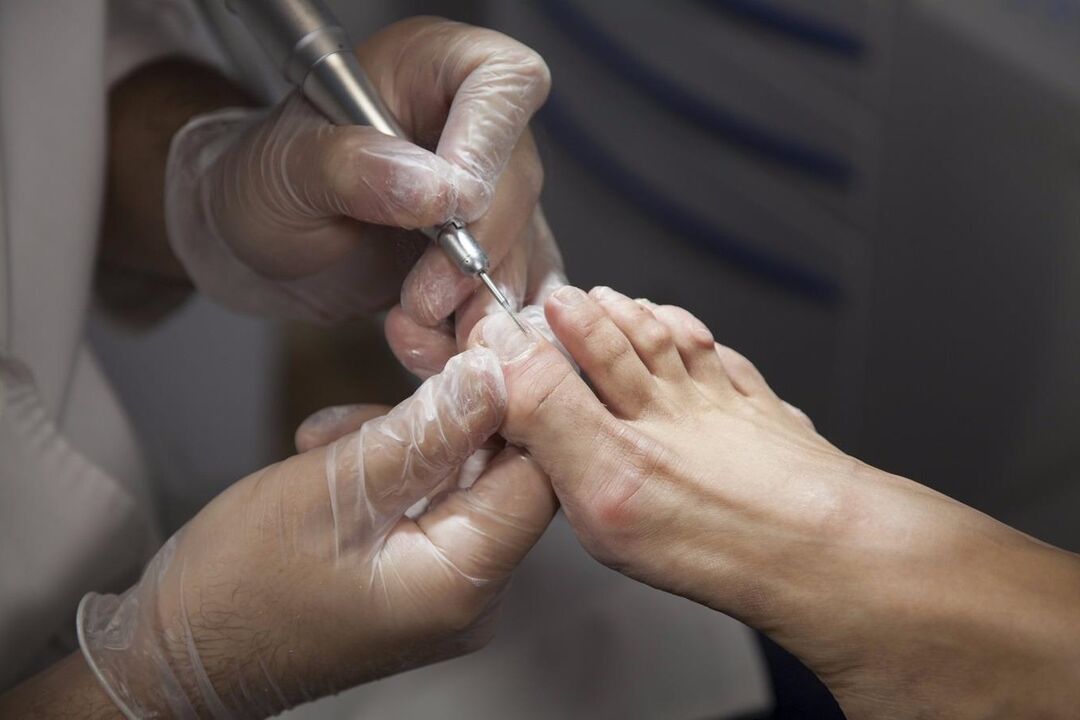The so-called nail fungus (onychomycosis) is one of the most common infectious dermatological diseases, and at the same time one of the most difficult to treat. The lack of obvious symptoms of infection in the initial stage of the disease is the reason for the late diagnosis of onychomycosis and, as a result, delays in treatment.

Types of mushrooms
Onychomycosis is caused by pathogenic fungi of the genus Trichophyton, which penetrate the tissues of the nail plate and nail bed, gradually destroying them and causing negative changes in local immunity.
Depending on the clinical manifestations of nail fungus, three forms of the disease are distinguished:
- Normotrophic - in this case, the nail plate maintains its normal thickness, but is painted in colors that are unusual for a healthy nail (cloudy white, yellow-gray, gray-brown, etc. ).
- The hypertrophic form is characterized by the excessive thickness of the nail, which rises above the surface of the nail bed and strongly protrudes beyond its borders. Often with this form, deformation of the plate is observed - it becomes pronounced with lumps, increases in width and causes pain when walking, as it grows in soft tissues.
- The atrophic form is manifested by the thinning of the nail, which takes on a cloudy color (sometimes with gray-yellow spots, lines or "air bubbles"). It is important to remember that only a specialist knows how to identify toenail fungus. Eliminating advanced nail fungus without surgery will be very difficult.

If you find any signs of fungus on the nails, hands or other formations, you should urgently seek advice from a dermatologist.
Symptoms
Manifestations of onychomycosis can be divided into three groups, which differ depending on the severity of damage to the nail plate.
- Of the scene (initial). At this stage of the development of the disease, the nail maintains its normal thickness and color, but its surface becomes matte and loses its shine. The cuticle and skin around the nail may appear extremely dry and keratinize quickly. At the same stage, scaly spots can be observed in the interdigital spaces and itching of varying severity - from mild and episodic to severe and permanent.
- Phase II (developed). In the second stage, visual signs of infection appear on the nail. The nail plate begins to thicken, but at the same time it becomes brittle - when cutting the nail, it is clear that it "crumbles", and uneven edges remain at the place of the cut. White, yellow, gray or brown spots or streaks appear on the nail, and the surface of the nail acquires an uneven relief. Thickening of the nail can develop to such an extent that any manipulation of it (manicure, pedicure) causes pain to a person. At this stage, an unpleasant smell appears from the affected nails (especially with onychomycosis on the feet), which cannot be eliminated with the help of hygienic procedures.
- Stage III (severe). At this stage of onychomycosis, the nail completely loses its functions and qualities, and the fungal infection spreads to the nail fold and the soft tissues under the nail. This stage is most often characterized by the death of the nail and its loss.
Causes of fungus

There is only one reason for onychomycosis: infection with pathogenic fungi and their growth and reproduction in the nail tissue.
But fungi, present almost everywhere, affect only a few people. The reason for this is simple: infection requires not only a pathogen, but also favorable conditions for infection.
This includes:
- Decreased local immunity. Skin and nails have their own resources to prevent infection. But when you wear tight and uncomfortable shoes, frequent or regular skin injuries, too full and deep pedicure/manicure, contact with aggressive substances, the protective functions of the skin and nails are weakened, which facilitates the penetration of fungi and reproductionher.
- Occupational or daily activities involving prolonged exposure of hands/feet to wet environments. This should not be direct contact with water or other liquids - wearing rubber shoes and gloves creates warm and moist conditions that are favorable for pathogenic fungi.
- Failure to observe the rules of personal hygiene provokes subungual mold. Wearing someone else's shoes, lack of individual shoes when visiting public pools and saunas, premature change of socks and stockings for fresh ones, etc.
Nail fungus: treatment

The treatment of onychomycosis is complicated by the peculiarities of the nails themselves, the density of which does not allow medicinal substances to penetrate into their deep layers.
Therefore, with fungal nail infections, an artificial reduction of nail thickness with the help of special nail files is often used. This frees the surface of the nail plate from the denser outer layer, which increases the ability of the active substances of the medicine to penetrate deeply.
With a deep lesion of the nail with the involvement of the nail bed tissue in the process, it is advisable to surgically remove the nail plate, which is performed under local anesthesia. After that, treatment is prescribed depending on the severity of the disease.
To date, the only way to get rid of onychomycosis is to use drugs from the antimycotic group. These drugs act selectively on pathogenic fungi, stopping their activity and reproduction and causing the death of pathogens.
Depending on the degree of proliferation of the fungus in the tissues surrounding the nail and whether the pathogen has invaded the bloodstream, systemic antimycotics for oral administration or agents that are effective when applied topically (ointments, creams, solutions) may be prescribed.

















